How to clean the toilet from urinary stone, rust and other deposits: the pros and cons of various methods
Perfect cleanliness in the bathroom is possible, but it takes a lot of effort. Most housewives are sure of this. However, if you know the nature of the pollution that appears inside the sanitary fixtures and use well-chosen means to combat them, the task is much easier.
Let's talk about how to clean the toilet quickly, efficiently and at little cost.
The content of the article:
The three main enemies of toilet cleanliness
A sparkling clean toilet is the pride of any housewife. Only now, unfortunately, he remains short-lived. Shortly after cleaning, unpleasant red stains may appear on the equipment surface.
These are streaks of rust, an oxidation product of iron or other metal alloys. It seems that she has nowhere to get in the toilet, which is made of ceramic using plastic parts.
However, there are several reasons for the appearance of rust. The first is the deplorable state of utilities. Old lines were made of non-galvanized metal, which inevitably corrodes over time.
Particles of oxides fall into the water, which leaves a rusty mark on the surface of the equipment.
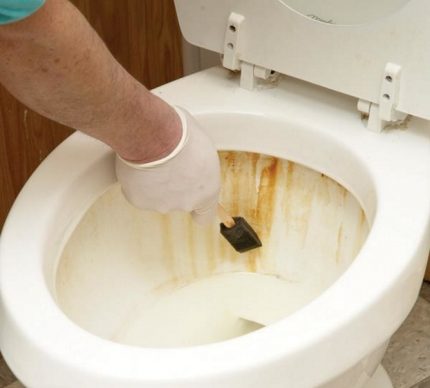
Common causes of rust stains include iron-enriched water entering the water supply and fluid leakage from the tank.
In addition to rust, leaves traces on the surface of the toilet limescale. The intensity of its formation depends on the composition of the water that is used in the plumbing system.
It necessarily contains various mineral compounds that settle on the walls of the toilet bowl and form an unpleasant hard grayish coating. The more calcareous compounds in the water, the faster the plaque appears.
And the third “enemy” of clean sanitary equipment is the urinary stone. It is formed similarly to limescale, the difference is only in its composition. The stone is formed from minerals contained in human urine.
With inaccurate use of the toilet bowl or with irregular flushing, urine residues linger on the surface of the toilet bowl, forming a hard coating of an unpleasant brown-yellow color.
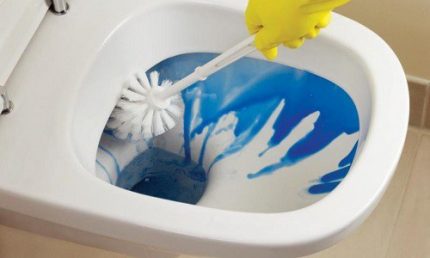
Thus, there are three main types of toilet contamination. They differ significantly from each other in their chemical composition, respectively, it will be possible to get rid of them using different means. Although there are universal methods of purification that will help in all cases.
I would like to note one more point. All types of contamination first begin to be deposited where the surface of the toilet has become roughened or microcracks have appeared.
More often than not, ceramics lose their smoothness after touching too hot liquids or objects. Sudden changes in temperature are also not very useful for the toilet, since microcracks can appear as a result.
You need to know that budget models of plumbing are produced from ordinary sanitary ware with a fairly high porosity. Such material is prone to the accumulation of contaminants. It is better to purchase equipment from sanitary porcelain, which is characterized by increased smoothness of the surface.
Where to start cleaning?
Whatever method of cleaning the toilet has been chosen, one should not forget about the preparation stage. First of all, you should take care of protection. All work must be carried out only with rubber gloves.
They protect the skin on the hands from aggressive cleansers, and elementary hygiene should not be forgotten. The toilet is a place of accumulation of pathogens.
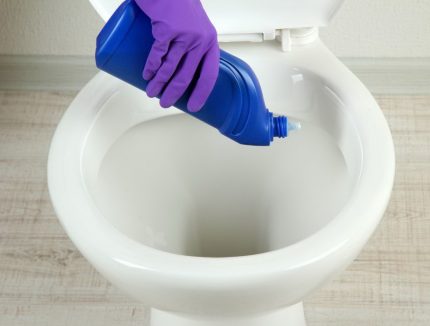
For the same reason, it is advisable to wear an oilcloth or plastic apron. It’s good that it covers as large a surface as possible. This will prevent the spread of germs on clothing. If aggressive chemicals are to be used, a respirator should not be neglected. Respiratory tracts must also be protected.
And a few more words about security. Try to prevent cleaning solutions from getting on the skin, and especially the mucous membranes. If drops of the drug nevertheless fall on them, immediately rinse them with water.
When working with pungent odors, always leave the toilet door open. The same should be done when gas is formed during the interaction of cleaning products.
It is advisable to start cleaning the toilet by removing water. It must be scooped out of the device and poured. For this, it is very convenient to use a bucket with a long handle. Only then can you start applying cleaners.
We fight pollution with folk remedies
Not all housewives are ready to use aggressive chemicals in the fight for cleanliness and prefer to do with milder “folk” remedies. There is nothing wrong with that, especially since these methods are quite effective.
Especially in the early stages when plaque and stone did not have time to harden too much. Consider how you can wash the toilet with popular gentle methods.
Method number 1 - soda with vinegar
It seems everyone knows how to wash the toilet with soda and vinegar, but there are some nuances. First we prepare baking soda, one package will be quite enough. After that, we moisten the inner surface of the equipment, so we will prepare it for processing.
We fill the toilet with soda. It will stick to a damp surface.If there are areas with plaque and stone, be sure to literally coat them with wet soda.
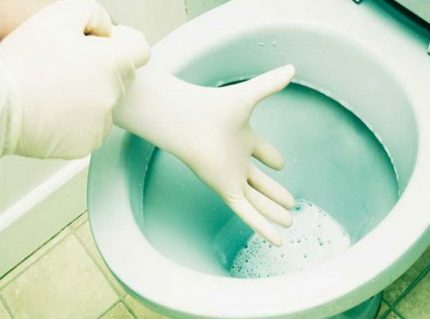
We leave the toilet in this form for about half an hour. During this time, soda will react with contaminants and begin to destroy them. After time, take a container with table vinegar. If only essence is available, it is best to dilute it. Carefully pour vinegar onto the surface of the toilet bowl sprinkled with soda. A violent reaction will begin, which will help to remove pollution.
We take a brush and wipe off the dirt, "helping" the seething chemical reaction. After its completion, we again brush through the bowl and rinse the toilet bowl thoroughly. It will take a few rinses, or if you do not want to wait until the tank is full, you can rinse the equipment with clean water from a bucket.
Method number 2 - mustard powder
First, prepare the cleaning mixture. To do this, take two tablespoons of mustard powder, add an equal amount of crystalline citric acid and four tablespoons of starch.
Mix thoroughly until a homogeneous mixture is obtained. We begin to gradually add pure water. Stir in such a way that gruel is obtained. This will be our cleaner.
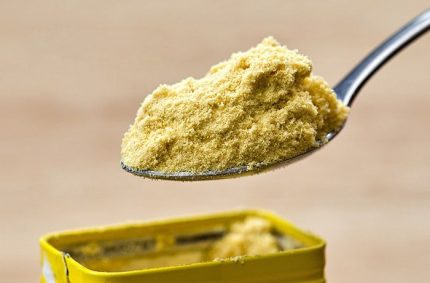
Moisten the surface of the toilet so that the mixture sticks better. Gently distribute the composition over the bowl. Rub the product thoroughly in especially contaminated areas and leave it in this form for about half an hour. Then rinse with water and at the same time with three brushes. We wash off the rest of the product with clean water.
Method number 3 - vinegar and salt
This method is especially effective for getting rid of urinary stone. We will need one glass of nine-percent table vinegar. If it is not, acetic acid can be diluted according to the instructions that are usually present on the bottle.
Pour vinegar into the dishes, which are not afraid of heating, and begin to heat the solution. It is important to remember that at this moment a pungent odor may appear, therefore it is advisable to close the container tightly.
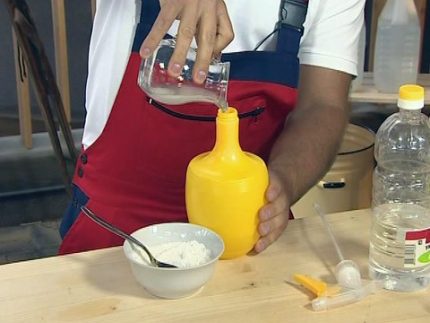
Vinegar is heated to a temperature of about 40C, after which we fall asleep half a teaspoon of salt and mix well. The resulting solution carefully treat the surface of the toilet. In areas with particularly severe pollution, we increase the amount of the product by rubbing it into the stone.
We close the toilet with a lid and leave it in this state for the night. In the morning we remove the solution along with impurities by letting water out of the tank.
Method number 4 - wood ash
To prepare the cleaning composition, we need an equal amount of wood ash and crystalline citric acid. Usually, two standard packs of “lemons” and the same amount of ash are enough. All mix well.
We moisten the toilet bowl and fill it with the resulting product. Leave as it is for the night. In the morning, we clean the toilet with a brush and rinse it, washing off the remnants of the product.
Solutions of acids of different concentrations
As you know, the acidic medium dissolves calcareous deposits and urinary stone very well. It is also effective against rust, so acids and products based on them are considered a good choice for cleaning the toilet.
In practice, various acids can be used without mixing with other substances. Using phosphoric acid is the best answer to the question of how to clean your toilet from rust.
The substance can easily be bought at a store where it is sold as an 85% solution.The product is a colorless syrup-like very aggressive substance. You can work with it only with the use of protection.
We prepare a cleaning agent: we take half a liter of pure water and dissolve 100 ml of phosphoric acid in it, mix until a homogeneous mixture is obtained.
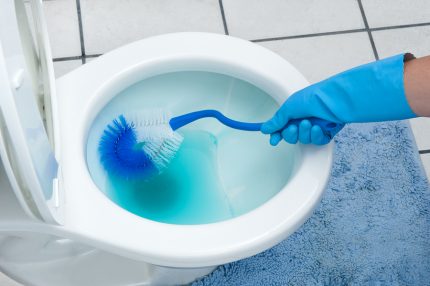
The bowl of the toilet is degreased by washing with any soapy detergent. After that, we apply the prepared cleaning agent, treat the surface with a brush, preferably with natural bristles. Leave the bowl with the solution for a while. Depending on the intensity of the pollution, it may take 1 to 12 hours.
After a while, wash the toilet with a weak soda solution. To prepare it, dissolve a tablespoon of soda in each liter of water.
To remove rust and plaque, hydrochloric acid is also used. But you need to know that it cannot be used for equipment with plastic and rubber parts, as well as its use is excluded if the toilet is connected to a plastic pipe. Acid will dissolve the plastic.
About half a glass of hydrochloric acid is poured into the bowl, where it is left for 15 minutes. Then the surface is washed with clean water.
It can be used to clean citric and acetic acids. Since their effect is somewhat weaker, the best results are obtained by such a technique. The toilet paper is impregnated with vinegar and placed under the rim and on contaminated sites.
They do the same with citric acid, but since it is crystalline, it may be more convenient to apply it to a damp cloth. The product is left for several hours, preferably at night. In the morning, washed with clean water.
Similar to citric acid, oxalic acid is used. This inexpensive product can be purchased at hardware stores.
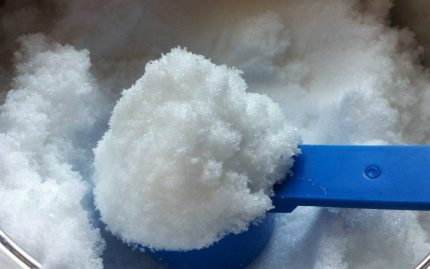
You can often hear tips on using battery electrolyte as a cleaning agent. It is really effective, you just need to remember that acids are part of the fluid, so do not forget about caution and protection. The bowl is treated with electrolyte, left for 20 minutes, then rinsed with water.
Abrasive cleaners
In compositions of this type abrasives are necessarily present. These are very small, but sharp and solid particles, with the help of which surface machining is carried out. Abrasives literally peel dirt, removing them from the surface. They are added in different amounts to the composition of cleaning products.
In any case, such mixtures are undesirable to use on ceramics. This is especially true for sanitary porcelain. Abrasives leave scratch marks on a smooth surface. Over time, they accumulate more and more, the bowl becomes rough, literally “attracting” pollution.
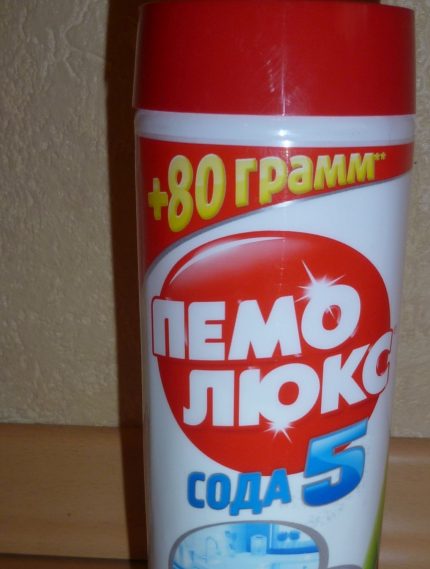
If you still want to use cleaning products of this type, you should read the instructions on the bank. Most often, in addition to abrasives, they include some kind of bleach. Therefore, most manufacturers advise using their products in this way.
The powder is applied to a sponge moistened with water or directly to the bowl, after which it is intensively rubbed into the surface. Then you should leave the product for a while so that it works effectively. Then again rub thoroughly with a sponge and rinse with water.
Industrial Cleaning Products
This is a large group of various compositions based on acids or alkalis.The former are more effective, since the acid copes better with the removal of rusty edema and limescale.
But alkaline products work well against organic matter, respectively, they decompose urine stone and fats perfectly. Consider the most popular formulations.
Gel-shaped “Cillit Bang” for toilets
All products manufactured under this brand have a gel consistency. They are packaged in bottles with a convenient dispenser in the form of a nozzle, which helps to deliver the solution to the most inaccessible places.
The main active ingredient in the composition of the product is hydrochloric acid. Therefore, it is best used against rust spots and limescale. In this case, do not forget about the means of protection.
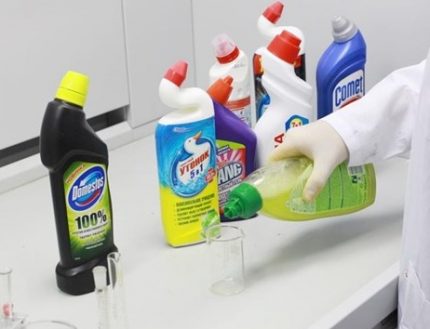
In the product line you can find formulations of directed action: against rust, for disinfection, for bleaching or shine, against hard-to-remove limescale. Consumers appreciate the high efficiency of the composition, economical consumption and convenient packaging.
Of the shortcomings, the relatively high cost of the drug is considered the most significant. But the gel is very easy to use. It must be applied to the bowl, left for 15-20 minutes, then rinse.
“Domestos” for the toilet
Under this brand, a popular multifunctional toilet and other plumbing cleaner is produced. The composition of the drug includes alkali, which copes well with the destruction of organics. For this reason, with a lime coating, the agent fights not very effectively.
In addition, the product contains chlorine bleach, so it not only bleaches rust streaks, but also disinfects surfaces.
Several varieties of the drug are available, differing mainly in fragrances. The latter are necessary to drown out the extremely unpleasant smell of chlorine. Consumers highly value the product for high efficiency, thick consistency and economical consumption. Of the shortcomings, a sharp unpleasant smell of the drug is noted.
Domestos is universal, in diluted form it can be used as bleach and as a disinfectant for kitchen work surfaces. And in undiluted form, it and other equally effective means can be used to eliminate blockages in sewer pipes.
Cleaning product “Toilet duckling”
A liquid preparation, produced in bottles of a characteristic shape with a strongly curved neck, which allows you to apply the gel in the most inaccessible places. The duckling contains hydrochloric acid, so it copes with lime deposits and rust streaks.
Somewhat worse, but it also effectively dissolves the urinary stone. The concentration of acid is quite high, so the tool is aggressive towards bacteria.

The drug has a pronounced disinfecting effect. When working with the composition, the use of protective equipment is mandatory. Buyers noted the good effectiveness of the drug, convenient packaging, budget cost.
The duckling contains chlorine derivatives, despite this it has a pleasant smell. The disadvantages include liquid consistency, which provokes a fast consumption of the drug.
Cleaning tablets and cubes
Many housewives, thinking about how to clean their toilet from urinary stone, do not take into account the numerous tabletted cleaning products. They are produced by most manufacturers of household chemicals. This is an effective multi-functional tool that can not only clean equipment, but also disinfect it and deodorize the air in the bathroom.
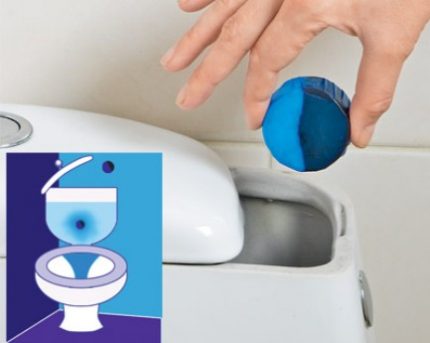
Well-known brands release funds that are valid for one to two months. A tablet in a water-soluble shell is lowered into a drain tank. Slowly dissolving, it gradually "gives" the active substance to the water. As a result, the details of the drain tank are cleaned. After pressing the flush button, the liquid enters the bowl, it is also cleaned of all types of contaminants.
At the same time, the active substances freely enter the most inaccessible areas and clean them. Means can have the most different aroma, the user selects any liked smell.
Tablets are quite effective, especially if there are no old pollution. Of the shortcomings of the drug, it is worth noting a fairly fast consumption of the drug, especially if a large number of people use the toilet.
Conclusions and useful video on the topic
Using video instructions, you can solve some of the problems associated with the pollution of sanitary equipment in the toilet.
A simple way to clean the toilet with Coca-Cola and citric acid:
Folk remedies for cleaning the toilet:
How to get rid of rust on the toilet bowl:
Cleaning the toilet is far from the most enjoyable of occupations. Nevertheless, this should be done regularly so that later aggressive chemicals are not needed to put equipment in order.
If the plumbing still has an unsightly appearance, you need to determine the nature of the contaminants and select the most effective cleaning agent especially for them, since their range is very, very wide.
There are other effective ways to clean the toilet from contamination, and you successfully apply them in practice? Please tell us about them to other visitors to our site in the comments section. Or have questions about the topic of the article? Ask them, we will understand together.

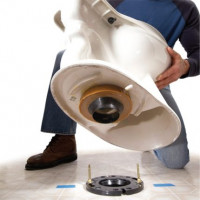 Vertical release toilet: device, pros and cons, installation features
Vertical release toilet: device, pros and cons, installation features  Monoblock toilet: device, pros and cons, how to choose
Monoblock toilet: device, pros and cons, how to choose 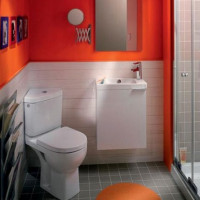 Corner toilet with a tank: pros and cons, scheme and features of installing a toilet in the corner
Corner toilet with a tank: pros and cons, scheme and features of installing a toilet in the corner 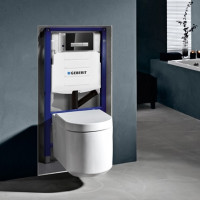 Wall-hung toilet with installation: selection rules, pros and cons of such a solution + installation steps
Wall-hung toilet with installation: selection rules, pros and cons of such a solution + installation steps 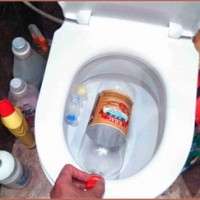 How to clean the toilet with a bottle: step-by-step installation + an overview of alternative methods
How to clean the toilet with a bottle: step-by-step installation + an overview of alternative methods 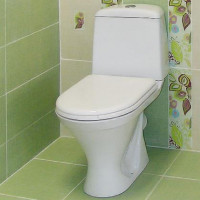 How to install a toilet on a tile: an overview of the best ways and technical nuances
How to install a toilet on a tile: an overview of the best ways and technical nuances  How much does it cost to connect gas to a private house: the price of organizing gas supply
How much does it cost to connect gas to a private house: the price of organizing gas supply  The best washing machines with dryer: model rating and customer tips
The best washing machines with dryer: model rating and customer tips  What is the color temperature of light and the nuances of choosing the temperature of the lamps to suit your needs
What is the color temperature of light and the nuances of choosing the temperature of the lamps to suit your needs  Replacement of a geyser in an apartment: replacement paperwork + basic norms and requirements
Replacement of a geyser in an apartment: replacement paperwork + basic norms and requirements
I regularly use some methods of cleaning the toilet, described here, however, the method using soda and vinegar aroused interest. If everything is clear with soda, you need one pack, but how much vinegar should you pour? Fortunately, it was not possible to clean hard-to-remove deposits, but I will take note. I believe the main method of cleaning is the systematic prevention, treatment of the toilet with various chemicals. Then you will not have to intensively look for a way to get rid of unwanted rust and deposits.
Each method has its pros and cons. Taking into account the chemical composition of the deposits that must be removed, I used the simplest way to dissolve carboxylic deposits. I took a concentrated vinegar essence, diluted with ordinary tap water, in a ratio of one to one. The resulting solution was poured into a regular sprayer, which remained with me after the glass cleaner was over. Using this sprayer several times I applied the liquid to the problem surface. Acid neutralized the alkali. The surface is clean.
Since this is a folk method, and as you know, all folk methods differ in approximation and a huge number of recipes, here you can experiment as you please. Try to mix one to one - I think this is the most effective option.
Friends, there is a simple way to solve this problem - acetic acid 70% and any gel, according to Art. spoon. Create a foam with a sponge, apply. After drying the foam, if necessary, repeat. Store the sponge in pl. a cup with a lid. Cheap and efficient.
Will soda damage the white tile?
Hello. It will not hurt if you use the solution. Of course, you should not scrub dry soda on a tile.